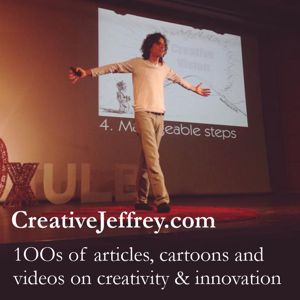 Imagination is the Root of Innovation
Imagination is the Root of Innovation
Imagination is the realm of the mind where you see things that do not yet exist in this world, but which one day might. It is an under-appreciated yet critical element of creativity and innovation. Imagination is defined as well as anywhere by Wikipedia as “the ability of forming mental images, sensations and concepts, in a moment when they are not perceived through sight, hearing or other senses”
Children, writers, artists and musicians are perceived as having the greatest imaginations. The novelist has to create in her mind characters, location, actions and plot. A great composer has to hear in her mind the interaction of many musical instruments in order to create a piece that stirs emotion.
Scientists too use imagination to formulate visions at the cosmological scale as well as at the atomic scale. Chemists, for instance, often imagine molecules interacting in order to anticipate and understand how chemicals will interact when combined.
In business, imagination is much less used and possibly even looked down upon. Having a great imagination would probably not come across as a compliment to most businesspeople, which is ironic as an awesome strategic vision can only occur in the mind of someone with a tremendous imagination. But when executives have an imagination, it is called vision. Frankly, I prefer my imagination as an imagination. It has served me well throughout my life.
Breakthrough Innovation Requires Breakthrough Imagination
Most organisational innovation programmes focus on verbal ideation. Brainstorms are traditionally about verbalising or writing down ideas according to written challenges. For example, the challenge, “In what ways might we improve the quality of our customer service?” is met with typical verbal suggestions such as “faster response”, “more polite staff” and so on. Such ideas are good, but they offer little more than incremental improvement.
A far better approach would be to imagine the ideal customer service representative. Imagine how she might dress, how she looks and how she interacts with people. Now imagine a typical customer contacting the representative. How does the customer act? How does the representative act? How does the customer respond and so on. Imagine different scenarios: a friendly customer, an angry one, a shy one and an abusive one. How does the interaction pan out each time. How could you make it better?
The more clearly you can imagine this scenario, the more likely you are to come up with truly creative ideas that have the potential to become major innovations.
But if you really want to push things to the limit, let your imagination run wild. Imagine your customer service representative was a friendly, loving dog. How would she act then? Or change her back into a human and imagine how she would act in the event a customer was in tears or became violent or threatened suicide. What if the customer was an alien from another planet? Think about others who serve people: priests, doctors, swimming instructors, teachers and so on. Imagine each as your customer service representative. Envision the scenarios that would occur. How would a customer service representative handle an angry terrorist with a bomb? How would she handle a depressed religious fanatic?
When you truly let your imagination run wild, there is a real opportunity to develop mind-blowing ideas that can become breakthrough innovations.
Firing People’s Imaginations
That’s all fine and dandy, of course. But how do you get colleagues and others to use their imaginations in developing ideas? You need to stimulate them. Typical verbal challenge statements like, “What kind of snack-food products can we make in order to exploit current fashions for healthier eating?” or “how might we improve communications across divisions of our global company?” do not inspire the imagination.
The first thing you can do is to move from typical challenge statement phrases like “In what ways might we...?” or “How might we...?” to calls to action very likely starting with the command to “Imagine”. For example: “Imagine you are eating a natural tasting and healthy snack food in a bag. What does it taste like? What does it smell like? What does it look like? What is it made from?” or “Imagine we want to create the snack food equivalent of fresh fruit. How might we do that?” or “Imagine you need information from the product management team in Singapore in the middle of the night their time. Imagine there is an easy way to do it. Draw it.”
An even better approach can be to remove as much as possible the need for words in the ideation process. Instead, try to work with models, toys, pictures and anything else that allows individuals or groups to build ideas. The design company Ideo is famous for this kind of approach. I have also had success with what I call “visual brainstorming” or “non-verbal brainstorming”. See http://www.creativejeffrey.com/creative/visual_brainstorming.php
With non-verbal brainstorming, you can give a team a big bag of children’s building blocks and tell them to: “design our new research and development labs”. You can give a team lots of pieces of Styrofoam, paper, glue, bits of wire, pens and other tools and ask them to build ideas. You can even use tools like Lego building bricks to represent lines of communication across the company (this is something Lego Serious Play consultants do).
Helping People Imagine
Unfortunately, the office desk with a computer on top of it is, for most people, the worst place in the world for imagination. So, you need to get colleagues out of their desks and into new spaces. Special creativity and innovation rooms, that are becoming ever more common in many companies, are a good solution. Leaving the company space all together and doing an imagination-inspiring activity in the countryside is good.
You can take people to a relevant place. For instance, if you are trying to come up with new product ideas, do the ideation in a supermarket and ask people to “Imagine an incredible new shampoo bottle that is so stunning it will grab your attention above all these other products on the shelf!”
Meditation
For people who find it hard to enter an imaginative state, consider meditation. An expert can help people clear their minds of distractions and then plant an image to help spark the imagination. This is something that I have done in a number of anticonventional thinking (ACT) workshops and the results have been impressive.
Imagination Is Not Just for Ideas
Imagination, like creativity, is not for exclusive use during the visionary idea generation phase. It is useful throughout the innovation process. For instance, in order to turn a new product idea into a manufacturable product, someone needs to visualise and design a production process. Someone else needs to design the components and someone needs to design packaging that not only protects the product but, in many cases, motivates people to pick up your boxed product in the shop, look at it and buy it. In other words, for a truly innovative product, you want great imaginations at every step of the innovation ladder.
Imagine an Imaginative Company
It is clear that organisations which strive to be innovative need to ensure that they employ imaginative people and exploit those imaginations. A good start might simply be to use the word “imagine” more and more often until people actually do start imagine. Indeed, just imagine how that would be in your company!
Imagination Rap
Imagination Rap - a light-hearted, very short and admittedly self-promotional song on the importance of imagination to innovation.
If you and your colleagues would benefit from learning how to use your imaginations better and more effectively in business, I can help through coaching, workshops and/or keynote speeches. Learn more about my services here or contact me and let's talk about how better use of the imagination will help your business innovate better.




